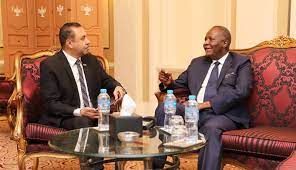In recent years, Zambia’s technological ecosystem has experienced growth on a scale that has never been witnessed before. As a result, participants in the sector are beginning to view it as the continent’s next big centre. The Honourable Felix Mutati, who serves as the Minister of Technology and Science in the country, speaks about the current situation of the technology business.
Read also: Airtel Zambia launches cutting-edge 5G Connectivity
Zambia technology background
When the pan-African e-commerce startup Wasoko announced its entry into the Zambian market two months ago, the company’s founder and CEO, Daniel Yu, cited “high smartphone usage and a pro-business government administration keen on expanding the country’s digital economy” as the reason for setting up shop in the southern African nation of Zambia.
Wasoko is not the first technology company to have established operations in “Zed,” as the country’s 19 million people lovingly refer to it. Wi-flix, a subscription video-on-demand platform; Liquid Intelligent Technologies, a technological infrastructure firm; VALR, a cryptocurrency exchange; and Chipper Cash, a fintech startup, are some of the companies that have recently joined the Zambian market. inq. has also revealed that it plans to establish its Artificial Intelligence Centre of Excellence in the country.
Vitalik Buterin, co-founder and inventor of Ethereum, the world’s second-largest cryptocurrency, has also declared his support for the tech scene in Zambia following a visit to the country in 2019 and a virtual meeting with President Hichilema in 2022. The digital ecosystem in Zambia is so promising that Buterin has stated his support for the tech scene in Zambia.
Insights from Zambia’s Minister of Technology and Science
Speaking to a source, Honourable Felix Mutati, Zambia’s Minister of Technology and Science, gives insights on the steps the country has implemented to increase technology, the obstacles the government has had in this process, and how they have solved them. He also discusses what the future holds for the technology industry in Zambia as well as the reasons why investors should flock to the nation of Zambia, located in southern Africa.
On how Zambia has been able to provide the conditions necessary for the rapid expansion of its technological ecosystem, the Minister that shared: first and foremost, they conducted an analysis to determine the degree to which the economy was equipped to be led by technology. When they conducted that evaluation, which was around two years ago, Zambia discovered that just 45% of the country was prepared for a digital revolution if they were going to have one. As a result of these discoveries, the Zambian Government was aware that they had a lot of groundwork to cover in order to improve our readiness from 45% to 100%.
He continued: “That heavy lifting was to be done through five pillars. The first pillar was the concept of a digital government, and this basically means how does government work itself incorporate technology? How does government work with the citizens? And how does government work with business? From that assessment I mentioned, we had realised that government preparedness in that regard was around 34%. The next pillar we assessed was digital financial inclusion, where we were at almost 70%. In digital literacy and skills, we were at 34% while for the digital infrastructure pillar, we were at 54%. On the last pillar, digital innovation and entrepreneurship, we were at about 40%.”
“Having defined the pillars and assessed our preparedness in each of them, we had an idea of what we needed to do in each of the pillars to move forward. We understood that first, we needed to create a correct policy, and from that, we began the journey to construct the ICT policy which was approved by the cabinet last week. In terms of the enabling legal framework, we looked at our data protection and cybersecurity and cybercrime in electronic transactions because those are key in terms of having an enabling environment that drives the digital transformation of the economy. So, that was the first phase.”
The Minister admits that the next stage consisted of locating other approaches to bolster Zambia’s preparedness inside those pillars.
“Number one was facilitating connectivity. How do we use digital infrastructure to connect businesses, citizens and government? What sort of technology did we need to deploy? So, in terms of enabling connectivity, we looked at a combination of communication towers and satellites. We did a proof of concept in ten provinces and identified that it would be cheaper to use low-orbit satellites in places where planting communication powers would be impractical and expensive. Having done that, our goal was to have 100% coverage by 2030 but because of the investments that we have done in the last two years, we have revised that target to have 100% by 2024.”
Next, a national digital identity was created. Since the existing identity is disjointed, Zambia needed data harmonisation to have a digital identity. Harmonisation will cost the government a lot, the Minister narrated. The government programmes function autonomously, creating silos. They developed the “interoperability system handshake” to fix this. This allows them to connect all these platforms so they can communicate across the digital ecosystem. Systems in the financial industry, government, and citizens can communicate with each other.
After that, there existed the foundation of cyber resiliency. When the Zambian Government talks about cyber resilience, they mean that once a transaction takes place, that transaction must be completed. Right now, Zambia is waiting for that to be finished because that is the only way one can build trust and confidence in digital technology, which will ultimately lead to an increase in adoption. If you do not have trust and confidence in digital technologies, their growth will be stunted as a result.
The final step was forming partnerships. They’re interested in learning more about effective collaboration between the public and private sectors. Private sector investments were found to be constrained by bureaucratic hurdles, rules, and regulations. To give just one illustration. If a telecommunications operator proposes a tower, the government must do an ecological review. The tower site must be evaluated before the company can issue certification. Consider that the company is building 200 towers across Zambia, all of which must be certified, but that the certification department only has four or five people working on them. It would take a very long time to set up just one organisation.
To rethink this, the government of Zambia said, “let’s break down this barrier, let them plant and then the assessments will be done.”
Taxes on the internet’s backbone were also done away with. In their opinion, taxation is impossible without the support of a robust digital infrastructure. Initiate the tax filing process by inviting them inside. In 2023, the government cut taxes so that businesses could invest in building skyscrapers, which in turn helped the economy. In the long run, this increases tax revenue. They also investigated options that would lessen the burden on the economy’s digital infrastructure.
They stated that three separate telecommunications companies operate in Zambia, meaning that they cannot all construct towers in the same area. As a result, they established guidelines for co-location. There will only be one tower for the three of you, as promised. Make room for your switched-on resources. Competition in the telecommunications industry must centre on services, not infrastructure.
Zambia was a defaulting nation and unable to get foreign aid until we restructured our debt two months ago. They essentially paved the way for the international credit line Zambia later defaulted on. After that happens, telecommunications firms will be able to attract foreign investment funds. To sum up, they have kept open lines of communication with the business sector, government, and public stakeholders and compared notes with them in order to arrive at a unified message on public concerns.
The challenges
The Minister shared that there have been many difficulties and obstructions to overcome. One illustration of this is the co-location of the towers that he discussed earlier. In the past, it was common practice for each telecom company to erect its own tower in the belief that doing so would help them maintain its share of a particular market.
Telling them to agree to share a single tower was obviously met with some resistance; nevertheless, they are now realising the value in that the amount of investment they need to make in infrastructure is now significantly lower than it had been previously. Another difficulty arose during the process of developing the national digital idea as a component of the digital identity pillar. The systems that were already in place were not connected to one another, which made it difficult to facilitate interoperability between the various systems.
He said, “In general, any change that you’re going to make, whether it’s digital or anything else in life really, is going to face resistance until the benefit of that change persuades the worthwhile recipient. For us, we understood this and sought to create as much value as possible for all stakeholders so that at the end of the day, after all these changes have been implemented, the stakeholders can say ‘Thank you digitalisation’.”
Zambian efforts to recognise tech as a contributor to the economy
The minister recognises that the growth of the IT industry is anticipated to be substantial this year, coming in at forty percent. This comes first and foremost with the prospects and jobs available in the technology sector. Two, when you connect different systems, you lower the cost of transactions all throughout the economy. When you do that, the private sector starts to expand, which is point number one in this list. Therefore, technology is the fuel that, for them, enables progress in fields such as agriculture, mining, manufacturing, education, and healthcare, amongst others.
“I’ll give an example of the influence that technology is having in the financial sector for example. One of the country’s biggest commercial banks is now able to reach and connect with customers all over the country because they are moving from brick-and-mortar banks to digital banks, a process which has been facilitated by the availability of digital infrastructure. So to include that person in rural locations who prefers cash, the bank has agents in these locations who facilitate transactions. These agents can employ up to three people each, and if you do the maths, that’s a lot of jobs created as these kinds of services scale,” he added.
















